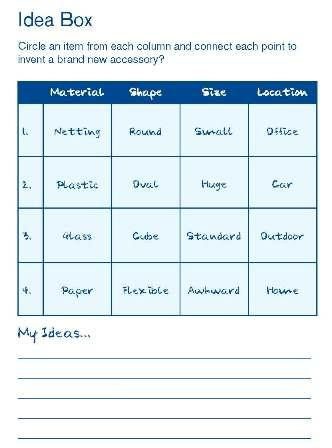 The Idea Box is a derivation of the Morphological analysis technique developed by Fritz Zwicky as a method for systematically structuring and investigating the total set of relationships contained in multi-dimensional problems.
The Idea Box is a derivation of the Morphological analysis technique developed by Fritz Zwicky as a method for systematically structuring and investigating the total set of relationships contained in multi-dimensional problems.
The Idea Box variation of this technique we like best is described by Michael Michalko in “Thinkertoys”, a book that should be on everyone’s shelf. The Idea Box is a matrix tool in which you insert all of the different parameters of a design so that you can see them clearly.
Simple How to…
Across the top, list different parameters (material, shape, target audience), then list options under each (i.e. audience – could be young, old, college student, CEO, parent).
Randomly select an option in each of the four columns, and link the 4 key words together to generate an idea. Repeat.
With clients we often use a 6×6 grid though a simple 4 x 4 matrix can give you 254 potential ideas/solutions.
Detailed Instructions…
The first step is to design your Idea Box, by identifying a number of essential parameters for the product/service you want ideas on. Then under each parameter list variations that could be part of the design, and maybe have a few that are bit ‘unusual’ or even provocative. This completes your box and can take some time. See the very simple example image from Michalko’s book.
Many Idea Boxes will have 6- 8 key parameters with as many at 10 variations under each, which as you will see provides an almost limitless combinations to invent your new product/service.
With the box now complete begin by randomly combining different variations of the parameters – select one variation from each paramater. If you have 10 parameters with 10 possible variations for each, there will be 10 billion possible combinations, so keep this in mind so that you’re idea box isn’t too complex.
The general procedure to implement this technique is the following:
Step 1. List all the major parameters involved in the issue, problem or product/service you are looking at. For example, the major elements of a product you’re trying to improve could be the material, the shape, and added features.
Step 2. Possible variables are then listed under each parameter. So under “material” the variables could be wood, steel, plastic, and so on.
Step 3. Start combining the variables together to try to come up with some novel ideas. Try to use all the variations in your design, forcing your thinking to stretch beyond the obvious. Don’t assess or critic too early, let the ideas flow.
Step 4. As ideas start to develop, analyse and build on them, and when ready decide which one to pursue to the next stages of design.
Let’s use the Idea Box above from Thinktoys to invent new ideas for products to be sold at a furniture store.
Let’s combine:
Material = Glass, Shape = Cube, Size = Awkward, Location = Outdoor
Now we just connect these and let our creativity flow. What comes to mind, what do we see? A glass cube that is awkward to handle and is outside.
- Immediately we might think of a large Aquarium on the patio, or that may be attached to our swimming pool as a feature.
- We also see a planter holding a unique tree or plants with unusual roots that create a great talking point.
- We might combine these ideas and have a large glass planter cube with a small tree that also has a below surface level pond that is a home for those air-breathing fish or frogs etc.
What do you see? Want to give it a try? Download our template to get started. Note in our template we add a last column called the FLIP, which is a random word provocation – this is optional to really provoke your thinking
